#renaissance fashion
Text
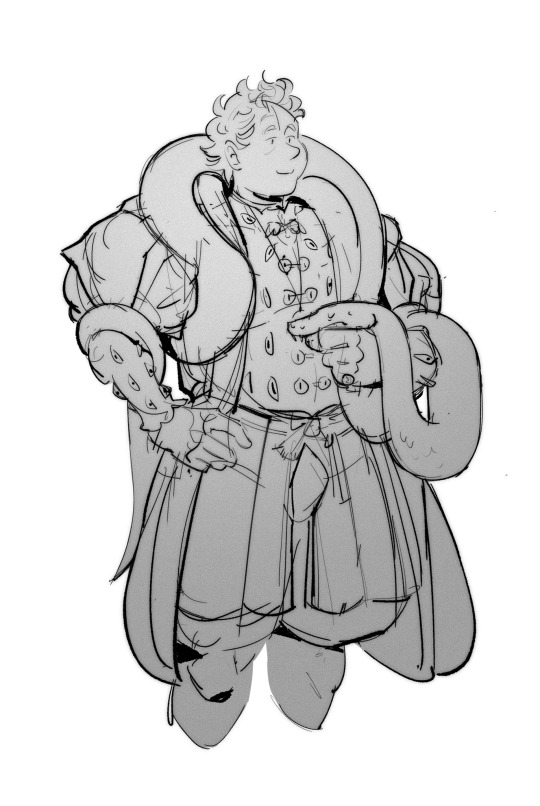
renaissance!Aziraphale (and Crowley). yeah, codpiece and snake and all. accessorized as hell. you know he would serve
#good omens#aziraphale#renaissance fashion#anyway the LIRR ticket taker who saw me drawing this asked if it was Bleach?? funniest /is that anime/ moment of my life#I had to tell someone#I didn’t realize there was a new Bleach anime last year so you can imagine my confusion at his assumption that this#was fanart of an anime that finished when I was still in high school
2K notes
·
View notes
Text

So I got this tag on my answer to an ask about when it became acceptable for western women to wear pants, and you know it's all I need to go on a tangent.
I think the short answer here would be men have worn skirts as long as people have worn anything, so pretty long tbh. But since I am incapable of answering anything shortly, I think we can re-frame this question:
When did skirts stop being socially acceptable for men?
So let's start with acknowledging that tunics, togas, kirtles and such men wore through history were, in fact, skirts. I think there's often a tendency to think of these as very different garments from those that women wore, but really they are not. Most of the time they were literally referred to with the same name. (I will do a very broad and simplified overview of men's clothing from ancient times to Early Middle Ages so we can get to the point which is Late Middle Ages.)
Ancient Greek men and women both wore chitons. Even it's length wasn't determined by gender, but by occupation. Athletes, soldiers and slaves wore knee-length chitons for easier movement. Roman men and women wore very similar garment, tunics. Especially in earlier ancient Rome long sleeves were associated with women, but later became more popular and unconventional for men too. Length though was still dependent on occupation and class, not gender. Toga was sure men's clothing, but worn over tunic. It was wrapped around the waist, like a dress would, and then hung over shoulder. Romans did wear leggings when they needed to. For example for leg protection when hunting as in this mosaic from 4th century. They would have been mostly used by men since men would be doing the kinds of activities that would require them. But that does not lessen the dressyness of the tunics worn here. If a woman today wears leggings under her skirt, the skirt doesn't suddenly become not a skirt.
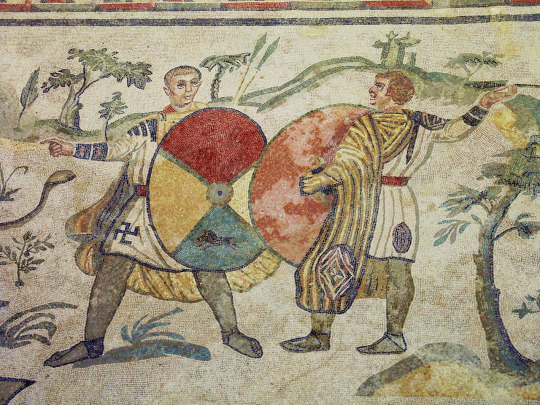
All over Europe thorough the early Middle Ages, the clothes were very similar in their basic shape and construction as in Rome and Greece. In Central and Northern Europe though people would wear pants under shorter tunics. There were exceptions to the everyone wearing a tunic trend. Celtic men wore braccae, which were pants, and short tunics and literally just shirts. Celts are the rare case, where I think we can say that men didn't wear dresses. Most other peoples in these colder areas wore at least knee-length tunics. Shorter tunics and trousers were worn again mostly by soldiers and slaves, so rarely any other woman than slave women. The trousers were though definitely trousers in Early Middle Ages. They were usually loose for easier construction and therefore not that similar to Roman leggings. However leggings style fitted pants were still used, especially by nobility. I'd say the loose trousers are a gray area. They wore both dresses and pants, but still definitely dresses. I'd say this style was very comparable to the 2000s miniskirts over jeans style. First one below is a reconstruction of Old Norse clothing by Danish history museum. The second is some celebrity from 2005. I see no difference.
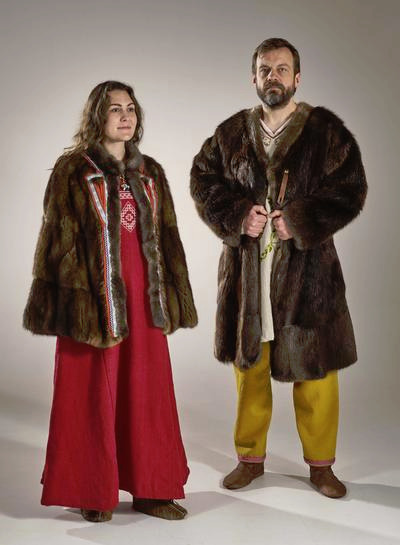
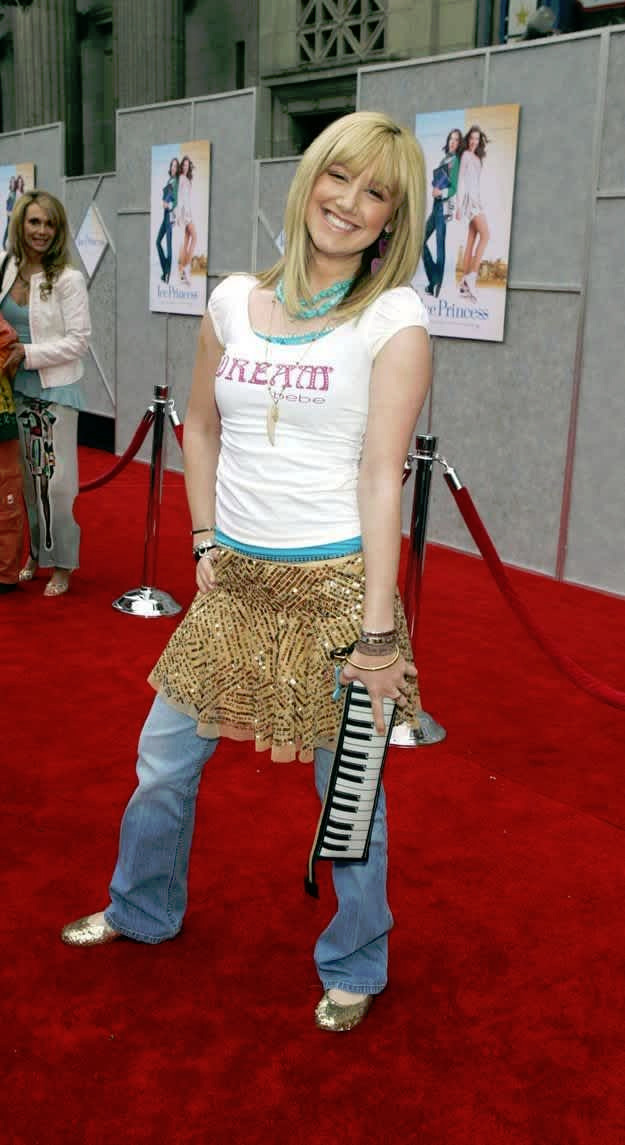
When we get to the high Middle Ages tunics are still used by both men and women, and still it's length is dependent on class and activity more than gender, but there's some new developments too. Pants and skirt combo is fully out and leggings' are back in in form of hose. Hose were not in fact pants and calling them leggings is also misleading. Really they are socks. Or at least that's how they started. As it has become a trend here they were used by everyone, not just men. During early Middle Ages they were worn often with the trousers, sometimes the trousers tucked inside them making them baggy. In high Middle Ages they became very long when used with shorter tunics, fully displacing the need for trousers. They would be tied to the waist to keep them up, as they were not knitted (knitting was being invented in Egypt around this time, and some knitting was introduced to Europe during middle Ages, but it really only took off much later during Renaissance Era) and therefore not stretchy. First picture is an example of that from 1440s. Another exciting development in the High Medieval era was bliaut in France and it's sphere of influence. Bliaut was an early attempt in Europe of a fitted dress. And again used by both men and women. The second illustration below from mid 12th century shows a noble man wearing a bliaut and nicely showing off his leg covered in fitted hose. Bliaut was usually likely fitted with lacing on the sides, but it wasn't tailored (tailoring wasn't really a thing just yet) and so created a wrinkled effect around the torso.
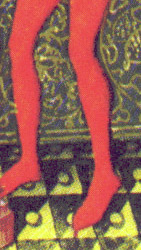

In the 14th century things really picked up in European fashion. European kingdoms finally started to become richer and the rich started to have some extra money to put into clothing, so new trends started to pop up rapidly. Tailoring became a thing and clothes could be now cut to be very fitted, which gave birth to fitted kirtle. At the same time having extra money meant being able to spend extra money on more fabric and to create very voluminous clothing, which gave birth to the houppelande.
Kirtle was once again worn by everyone. It wasn't an undergarment, for women that would be shift and men shirt and breeches, but it was an underlayer. It could be worn in public but often had at least another layer on top of it. The bodice part, including sleeves were very fitted with lacing or buttons (though there were over-layer kirtles that had different sleeves that changed with fashions and would be usually worn over a fitted kirtle). Men's kirtles were short, earlier in 14th century knee-length but towards the end of the century even shorter styles became fashionable in some areas. First picture below shows a man with knee-length kirtle from 1450s Italy.
Houppelande was also unisex. It was a loose full-length overgown with a lot of fabric that was gathered on the neckline and could be worn belted or unbelted. The sleeves were also wide and became increasingly wider (for men and women) later in the century and into the next century. Shorter gowns similar in style and construction to the houppelande were also fashionable for men. Both of these styles are seen in the second picture below from late 14th century.
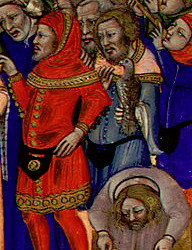

In the very end of 14th century, first signs of pantification of men can be seen. In France and it's sphere of influence the skirt part of the kirtle became so short it barely covered the breeches as seen below on these fashionable musicians from 1395-1400 France. Long houppelandes, length ranging from floor to calf, were still used by men though (the second picture, 1414 France), as were knee and thigh length gowns of similar loose style.

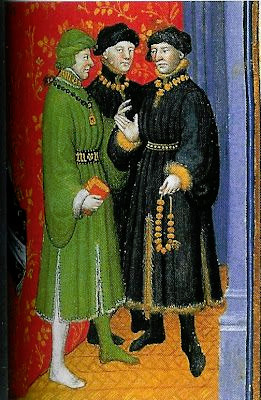
The hems continued to be short through the 15th century in France, but in other places like Italy and German sphere of influence, they were still fairly long, at least to mid thigh, through the first half of the century. In France at some point in late 13th century the very short under-kirtle started to be called doublet and they are just getting shorter in 1400s. The showing underwear problem was fixed by joined hose and the codpiece, signaling the entrance of The Sluttiest Era of men's fashion. Below is an example from 1450s Belgium of doublet and early codpiece in display. As you can see from the other figures, the overgowns of the previous century were also getting very, very short. In the next French example below from 1470s we can see the skirt shrink out of existence right before our eyes.
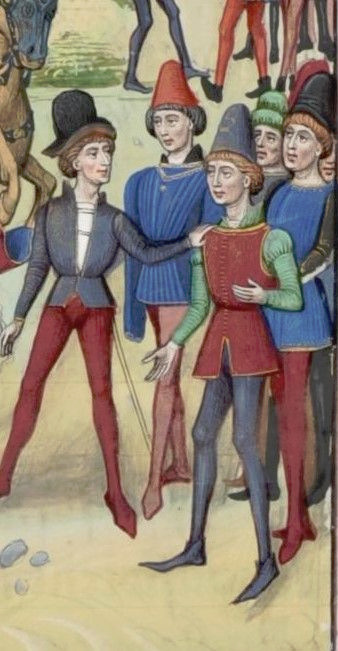

The very skimpy doublet and it's accompanying codpiece spread to the rest of the Europe in the second half of 15th century and it would only get sluttier from there. The Italians were just showing their full ass (example from 1490s). The dress was not gone yet though. The doublet and codpiece continued to be fashionable, but the overdress got longer again in the French area too. For example in the second example there's Italian soldiers in a knee length dresses from 1513.
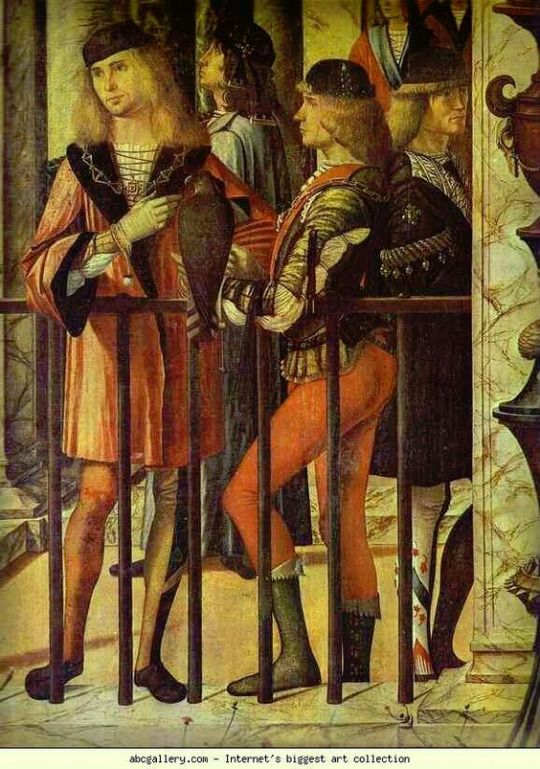
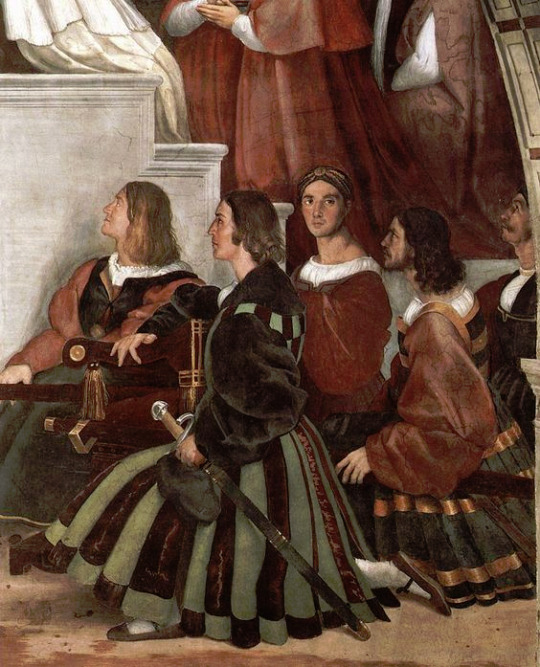
But we have to talk about the Germans. They went absolutely mad with the whole doublet and codpiece. Just look at this 1513 painting below (first one). But they did not only do it sluttier than everyone else, they also changed the course of men's fashion.
Let's take a detour talking about the Landsknecht, the mercenary pikeman army of the Holy Roman Empire. (I'm not that knowledgeable in war history so take my war history explanation with a grain of salt.) Pikemen had recently become a formidable counter-unit against cavalry, which earlier in the Medieval Era had been the most important units. Knights were the professional highly trained cavalry, which the whole feudal system leaned against. On the other hand land units were usually not made of professional soldiers. Landsknecht were formed in late 15th century as a professional army of pikemen. They were skilled and highly organized, and quickly became a decisive force in European wars. Their military significance gave them a lot of power in the Holy Roman Empire, some were even given knighthood, which previously wasn't possible for land units, and interestingly for us they were exempt from sumptuary laws. Sumptuary laws controlled who could wear what. As the bourgeois became richer in Europe in late Middle Ages and Renaissance Era, laws were enacted to limit certain fabrics, colors and styles from those outside nobility, to uphold the hierarchy between rich bourgeois and the nobles. The Landsknecht, who were well payed mercenaries (they would mutiny, if they didn't get payed enough), went immediately absolute mad with the power to bypass sumptuary laws. Crimes against fashion (affectionate) were committed. What do you do, when you have extra money and one of your privileges is to wear every color and fabric? You wear every color and fabric. At the same time. You wear them on top of each other and so they can be seen at the same time, you slash the outer layer. In the second image you can feast your eyes on the Landsknecht.


Just to give you a little more of that good stuff, here's a selection of some of my favorite Landsknecht illustrations. This is the peak male performance. Look at those codpieces. Look at those bare legs. The tiny shorts. And savor them.
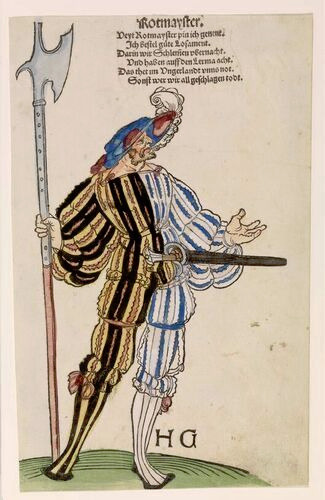
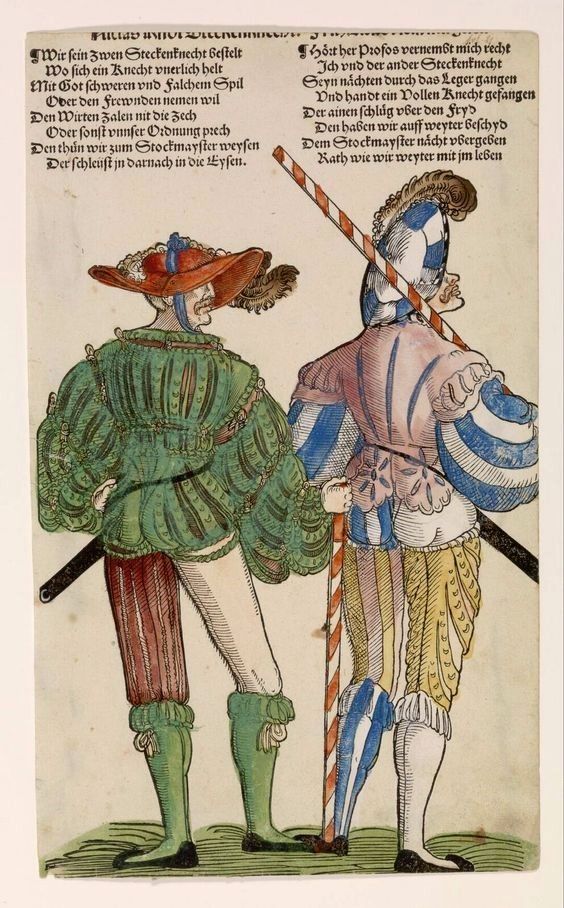
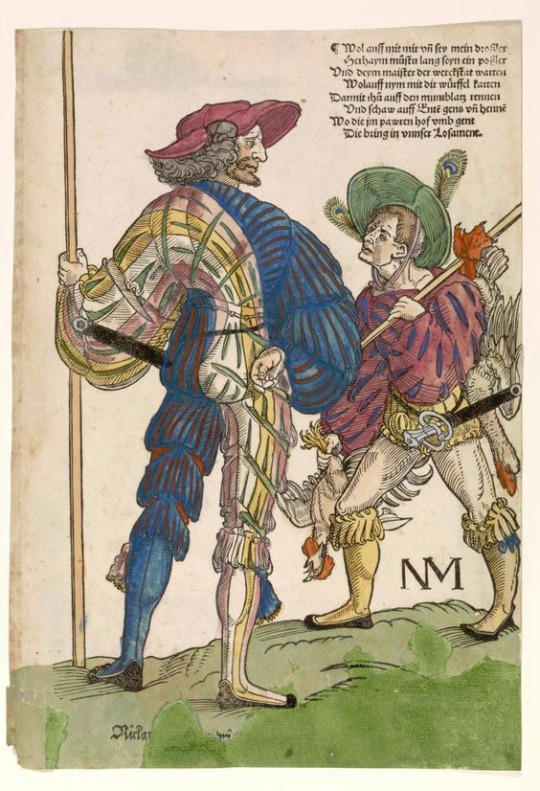
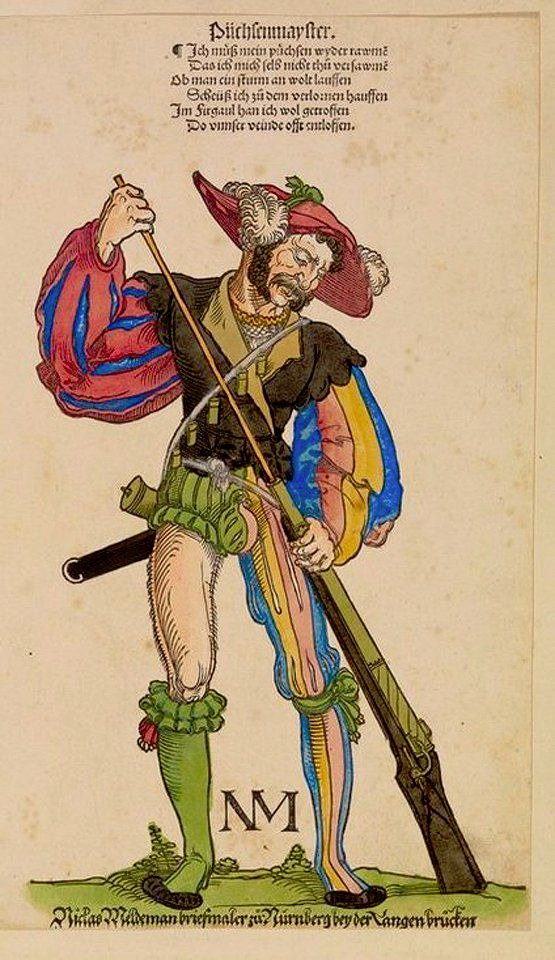
The Landsknecht were the hot shit. Their lavish and over the top influence quickly took over men's fashion in Germany in early 1500s. Slashing, the technique possibly started by them, but at least popularized by them, instantly spread all over Europe. That's how you get the typical Renaissance poof sleeves. They at first slashed the thighs of their hose, but it seems like to fit more of everything into their outfits, they started wearing the hose in two parts, upper hose and nether hose, which was a sort of return to the early Medieval trousers and knee-high hose style. The two part hose was adopted by the wider German men's fashion early in the century, but already in 1520s had spread to rest of Europe. It was first combined with the knee-length overdress that had made it's comeback in the turn of the century, like in this Italian painting from 1526 (first image). At this point knitting had become established and wide-spread craft in Europe and the stockings were born, replacing nether hose. They were basically nether hose, but from knitted fabric. The gown shortened again and turned into more of a jacket as the trunk hose became increasingly the centerpiece of the outfit, until in 1560s doublet - trunk hose combination emerged as the standard outerwear (as seen in the second example, 1569 Netherlands) putting the last nail on the coffin of the men's dress as well as the Sluttiest Era. The hose and doublet became profoundly un-slutty and un-horny, especially when the solemn Spanish influence spread all over with it's dark and muted colors.


Especially in Middle Ages, but thorough European history, trousers have been associated with soldiers. The largely accepted theory is that trousers were invented for horse riding, but in climates with cold winters, where short skirts are too cold, and long skirts are still a hazard when moving around, trousers (with or without a short skirt) are convenient for all kinds of other movement requiring activities like war. So by adopting hose as general men's clothing, men in 1500s associated masculinity with militarism. It was not a coincidence that the style came from Landsknecht. I may have been joking about them being "peak male performance", but really they were the new masculine ideals for the new age. At the time capitalism was taking form and European great powers had begun the process of violently conquering the world for money, so it's not surprising that the men, who fought for money and became rich and powerful doing so, were idealised.
Because of capitalism and increasingly centralized power, the feudal system was crumbling and with it the feudal social hierarchy. Capitalism shifted the wealth from land ownership (which feudal nobility was built upon) to capital and trade, deteriorating the hierarchy based on land. At the same time Reformation and centralized secular powers were weakening the power of the Church, wavering also the hierarchy justified by godly ordain. The ruling class was not about to give up their power, so a new social hierarchy needed to form. Through colonialism the concept of race was created and the new hierarchy was drawn from racial, gender and wealth lines. It was a long process, but it started in 1500s, and the increasing distinction between men's and women's fashions was part of drawing those lines. At the same time distinctions between white men and racialized men, as well as white women and racialized women were drawn. As in Europe up until this point, all over the world (with some exceptions) skirts were used by everyone. So when European men fully adopted the trousers, and trousers, as well as their association to military, were equated with masculinity, part of it was to emasculate racialized men, to draw distinctions.
Surprise, it was colonialism all along! Honestly if there's a societal or cultural change after Middle Ages, a good guess for the reason behind it is always colonialism. It won't be right every time, but quite a lot of times. Trousers as a concept is of course not related to colonialism, but the idea that trousers equal masculinity and especially the idea that skirts equal femininity are. So I guess decolonize masculinity by wearing skirts?
#this has been sitting in my drafts almost finished for like a year or something#historical fashion#fashion history#fashion#history#dress history#men's historical fashion#renaissance fashion#medieval fashion#western fashion#western fashion history#landsknecht
3K notes
·
View notes
Text

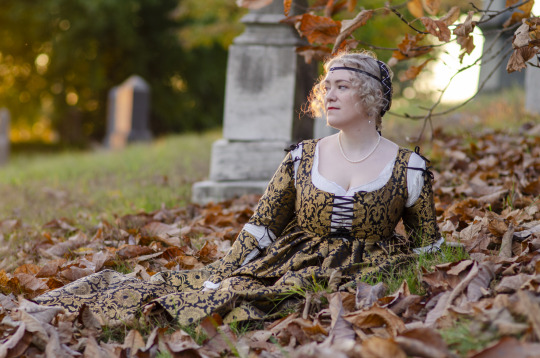

I was finally able to get some nice photos of my 1490s Italian ensemble (I made the dress last spring....and the headpiece last night 😅). I used one of Margo Anderson's patterns for the dress but ended up altering it a great deal bc the sizing was pretty odd & I didn't like the angle of the straps.
[Photos by @/danbanstudio on IG]
418 notes
·
View notes
Photo
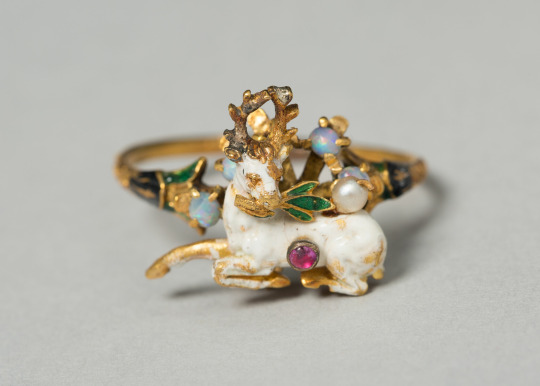
Stag with Herb Branch Mounted as a Ring
Date: c. 1550 - c. 1600 (stag), mounted on later ring
Artist: German or French
Medium: Gold, enamel, ruby, opals, and pearls
Dimensions: Diam.: 2.2 cm (13/16 in.)
Source: Art Institute of Chicago
2K notes
·
View notes
Note
I'm pulling you back onstage, what's this about the dangers of white lead makeup being known already at the time it was used?
They were!

Giovanni Paolo Lomazzo, writing in 1598. For anyone who's struggling with the typeface (spelling preserved):
OF CERUSSE, AND THE EFFECTS thereof.
The Ceruse, or white lead, which women use to better their complexion, is made of lead and vineger; which mixture is naturally a great drier; and is used by the Chirugions [surgeons] to drie up moiste sores. So that those women which use it about their faces, doe quickly become withered and gray-headed, because this doth so mightely drie up the naturall moysture of their flesh. And if any give not credite to my reporte; let them but observe such as have used it, and I doubt not but they will easily bee satisfied.
That's putting it mildly- ceruse could also cause skin peeling, hair loss, paralysis, seizures, organ damage, a host of other symptoms, and even death. But still, they were at least aware that it was Not GoodTM, and it's possible other sources I haven't read more accurately stress the gravity of the danger. Certainly it was known to be deadly by the 18th century, when the death of 27-year-old socialite Maria Gunning, Countess of Coventry was ascribed to her alleged use thereof. (I've never seen proof of this, and it's important to remember that as an Irishwoman, she may have faced undue hostility in English high society- and had very light skin naturally).
It's also difficult to trace just how popular ceruse even was, because less harmful forms of white face paint and powder also existed. One could speculate that this woman or that used ceruse, but nobody did a survey of such things. It was definitely real- cosmetic white lead tablets have been found dating as far back as ancient Greece -but whether it was the Sephora foundation of its day or the BBL (ie a dangerous beauty aid that a few devotees turned to but most eschewed) cannot truly be known.
By the 19th century, ceruse makeup had passed completely out of use as far as I know. Its legend grew as a cautionary tale on the dangers of vanity; the "fact" that Queen Elizabeth I used it was repeated over and over until it became common- if totally unsupported -knowledge. They had arsenic complexion wafers in the latter half of the 1800s- although one brand much advertised in the US was tested by contemporary scientists and found to be mostly lactose with only tiny amounts of arsenic or none at all, so cost-cutting entrepreneurs may have accidentally prevented illness or death. IF the wafers were popular at all, which once again remains unknown- certainly few letters and diaries I'm aware of mention them, if any.
(Interestingly, there's an echo of Maria Gunning's legend in Victorian newspaper stories about socialites "enameling," or applying a plaster-like layer of semi-permanent toxic makeup to their faces. Enameling was alleged to be undetectible but It's Definitely There; Trust Us; A Friend Of A Friend Of Alva Vanderbilt's Cousin's Underbutler Said, etc. This is similarly lacking in any solid evidence; recipes for a product called "enamel" do exist in period texts, but it always seems to be more akin to liquid foundation today, and I've personally only seen one such preparation containing lead. Many even included zinc oxide, which might have provided some unintentional SPF.)
#ask#sorcerorvaati#history#fashion history#makeup#renaissance fashion#I DID find a recipe for theatrical greasepaint with asbestos in it from 1893 which. YikesTM
151 notes
·
View notes
Text



men's fashion
in a book of domestic and foreign costumes, bavaria, late 16th century
source: Munich, BSB, Cod.icon. 341, fol. 5v, 102v and 107v
#first guy is from augsburg (bavaria)#second and third are italian#16th century#history of fashion#renaissance fashion#illuminated manuscript
215 notes
·
View notes
Photo
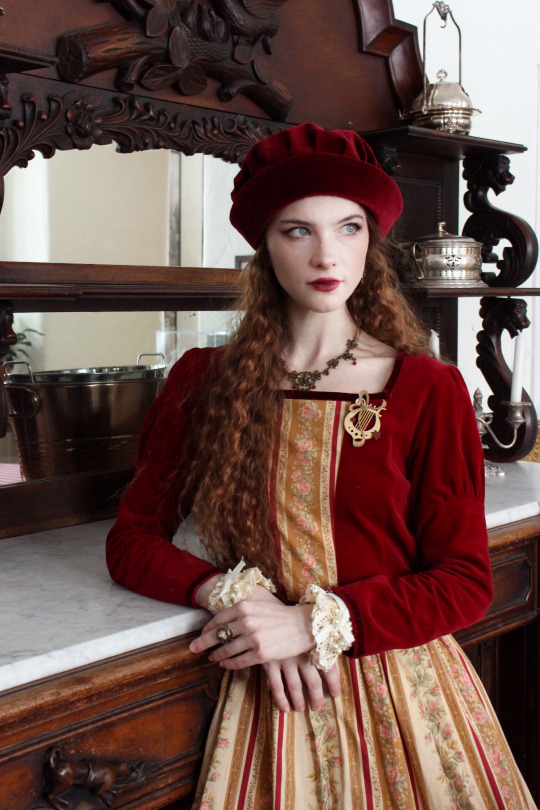

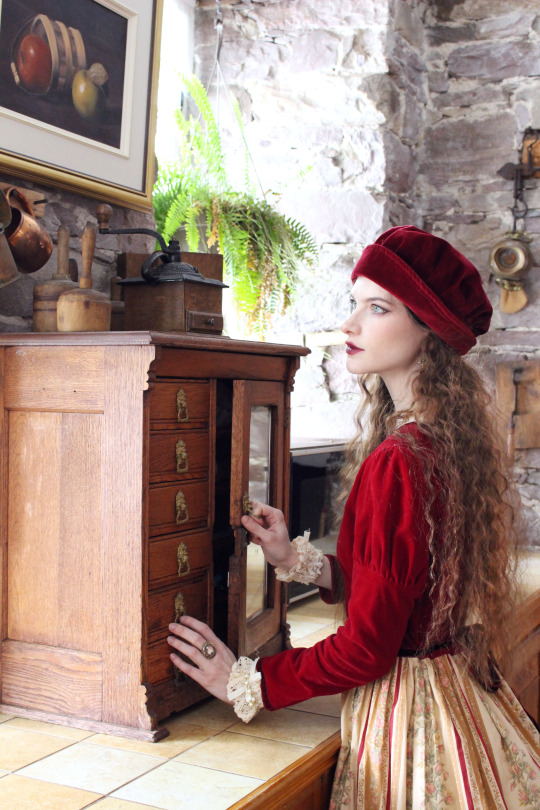



The spinster of the Maison Trestler (fictional)
Yet another uncategorisable style, vaguely inspired by Renaissance and Baroque fashion, mixed with lolita and theatre skirt length. Velvet season is still very much going on here.
Outfit rundown
Dress: second-hand Seraphim
Bonnet: vintage
Shoes: old Fluevog
Wrist cuff: old Belle Bête
Necklace and earrings: old Dracolite
Wood harp pin: Zackzack Seiffen
Ring: vintage
#fashion#vintage#vintage style#vintage fashion#vintage aesthetic#lolitafashion#egl#classiclolita#seraphim#historybounding#renaissance fashion#baroque#antique#antique decor#historical house#old house#maison trestler#long hairstyles#makeup#fluevog#red velvet#fanny rosie#fannyrosie
386 notes
·
View notes
Text
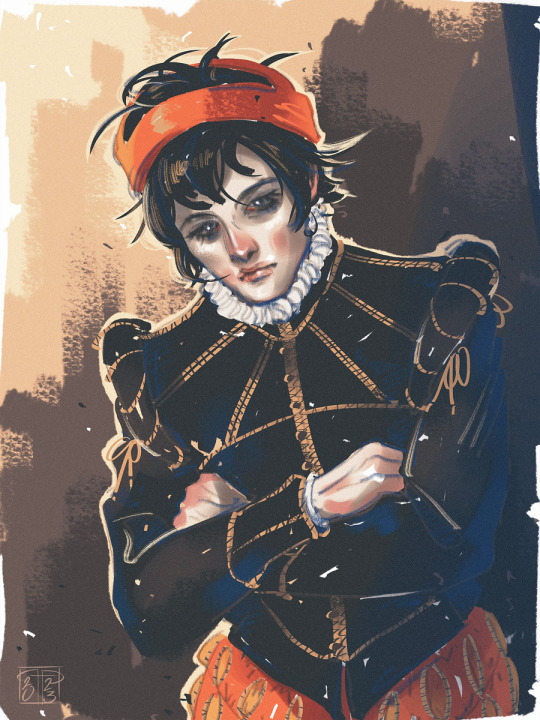
Vento Aureo • 1600 AU (JJBA)
Narancia Ghirga
Just want to save more details of the original design that fit well with the historical fashion.
Do not use
#vento aureo#golden wind#jjba part 5#16th century#17th century#artists on tumblr#himmelgrau#narancia#narancia ghirga#jojo#jojos bizarre adventure#renaissance fashion#renaissance#1500s#1600s#1600 au#jojo part 5#digital drawing#my art#illustration#renaissance au
206 notes
·
View notes
Text
What Laena Velaryon would have worn...
(RENAISSANCE PERIOD)





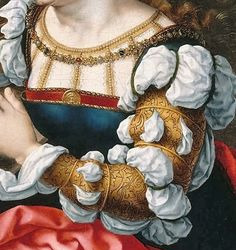
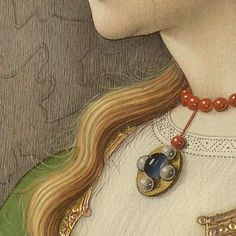
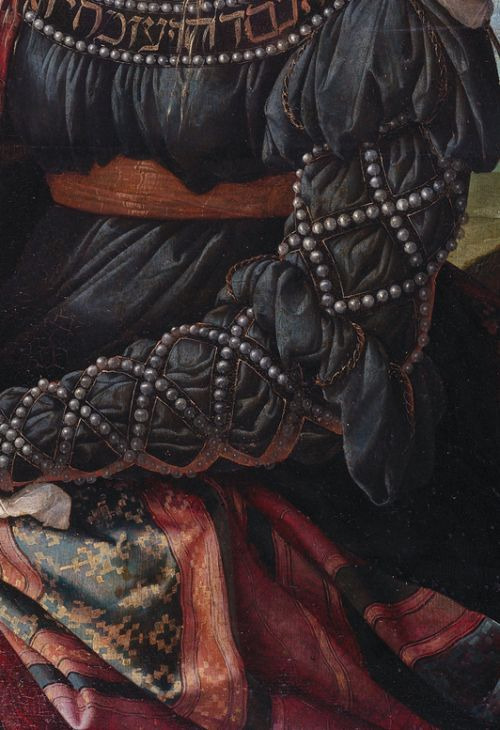


#hotd#house of the dragon#rhaenyra targaryen#the dance of the dragons#asoiaf#asoif/got#pre asoiaf#history#fantasy#team black#a song of ice and fire#renaissance#renaissance art#renaissance fashion#renaissance era#historical fashion#westeros#historical parallels#parallels#laena velaryon#lady laena#house velaryon
60 notes
·
View notes
Text



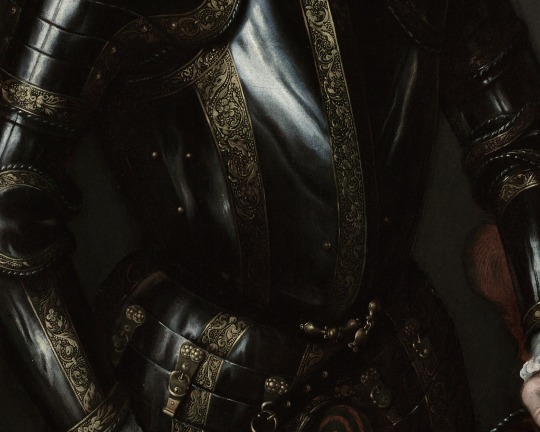

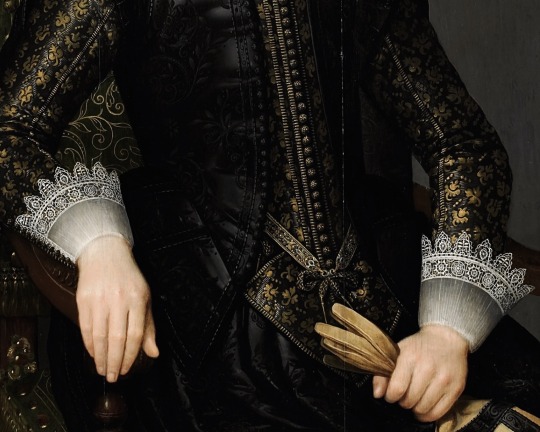
black clothing art details
sources: 1 2 3 4 5 6
#art#art history#gothic#art detail#gothic fashion#gothic academia#dark renaissance#renaissance#Renaissance clothing#renaissance fashion#tudor fashion#tudor#my p0$t#shit the Nilfgaardians would wear#style
64 notes
·
View notes
Text
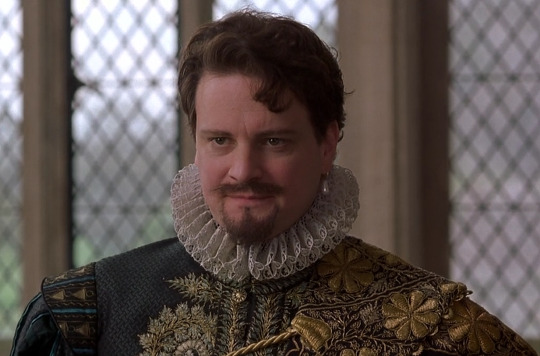




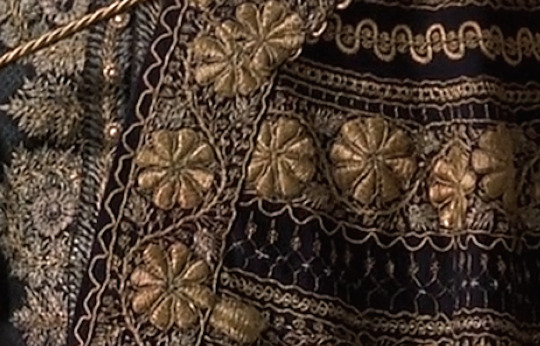
One Dress a Day Challenge
November: Oscar Winners
Shakespeare in Love / Colin Firth as Lord Wessex
Year: 1998
Designer: Sandy Powell
I've featured some of the women's costumes from this film before, but the men deserve some attention as well. Lord Wessex wears this magnificent outfit when he comes to inform Viola that a match has been arranged between them. The embroidery on his doublet and cloak is simply jaw-dropping in its variety and intricacy. I've included some closeups to show both the details of the embroidery and the texture of the various materials.
It's a shame we can't see what he's got for footwear, and we also never see him wearing the hat. He also manages to make the ruff look like something a person might actually wear on a regular basis.
#shakespeare in love#oscar winners#colin firth#one dress a day challenge#one dress a week challenge#movie costumes#period film#1590s fashion#1590s style#1998 movies#1998 films#16th century costumes#renaissance costumes#renaissance fashion#renaissance style#sandy powell#all the embroidery
77 notes
·
View notes
Text

#mystical coquette#whimsigothic#chainmail#knightcore#medieval#fashion#coquette fashion#mystical coquette fashion#fairycore#mystical#whimsigoth#whimiscal#chains#ren faire#renaissance faire#renaissance fashion
110 notes
·
View notes
Note
I've seen a post you've reblogged and added to, among many things about women showing nipples. Can you recommend any ref material (articles, videos, etc.) are share your knowledge about this? Cause I'm curious about that, as nowadays going out in a shirt without a bra makes you indecent, while in like 90s it was okayish? I wonder how it was in previous centuries.
There is a really cool academic paper about bare breast dresses in 17th century England specifically. I think anyone can read it by creating a free account.
Abby Cox also has a good video about the cleavage during the past 500 years in which she goes through also the nip slip phenomena.
I don't have other sources that specifically focus on this subject, though many sources about specific decades touch on it, but I do have my primary source image collection, so I can sum up the history of the bare nipple.
So my findings from primary source images (I could be wrong and maybe I just haven't found earlier examples) is that the Venetians were the first ones to show the nipple for courtly fashion. At the same time in other places in Europe they sported the early Elizabethan no-boob style that completely covered and flattened the chest. In the other corners of Italy the necklines were also low but less extreme. Venetian kirtle necklines dropped extremely low as early as 1560s and they combined extremely sheer, basically see-through partlets with their kirtle. First example below is a 1565-70 portrait of a Venetian lady with the nipples just barely covered waiting slip into view with a movement of arm. There was an even more extreme version of this with the kirtle being literally underboob style, still with a sheer doublet. Though I believe this was not quite for the respectable ladies, since I have only seen it depicted on high class courtesans. They were not exactly respectable ladies, but they did have quite good social position. The second example is a 1570s depiction of a courtesan, which is revealed by the horned hairstyle. By the end of the century this underbust style with only see through fabric covering breasts, had become respectable. In the last example it's shown on the wife of the Venetian doge in 1597.
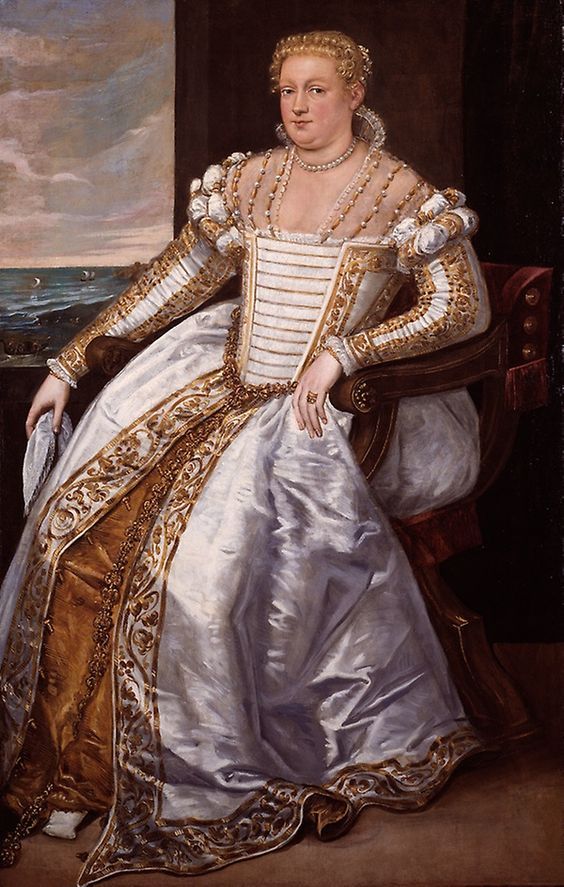
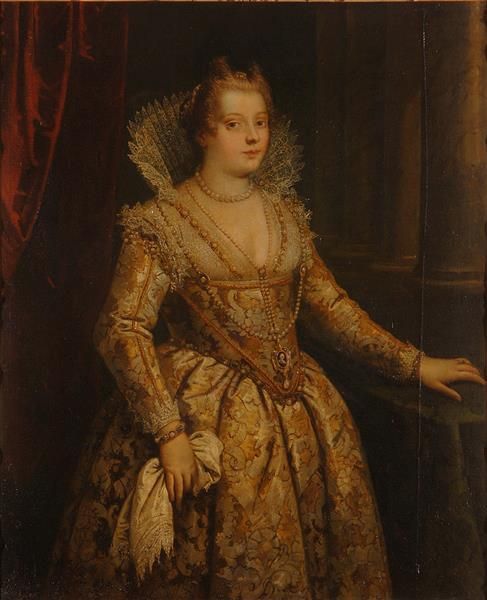

Around the same time, at the very end of 1500s, the extremely low cut bodice fashion enters rest of Europe. The low cut style was present in the bodices of all classes, but the nipple was really only an aristocrat thing. The lower classes would cover their breasts with a partlet, that was not sheer. Bare breast was ironically from our perspective a show of innocence, youthful beauty and virtue, and to pull off the style with respect, you also had to embody those ideals. Lower class women were considered inherently vulgar and lacking virtue, so a nipple in their case was seen as indecent. Bare boobs were also a sort of status symbol, since the upper class would hire wet nurses to breastfeed their children so they could show of their youthful boobs.
Covering partlets and bodices were still also used in the first decade of 1600s by nobles and the nip slip was mostly reserved for the courtly events. The first image below is an early example of English extremely low neckline that certainly couldn't contain boobs even with a bit of movement from 1597. The 1610s started around 5 decades of fashion that showed the whole boob. The first three were the most extreme. Here's some highlights: The second image is from 1619.
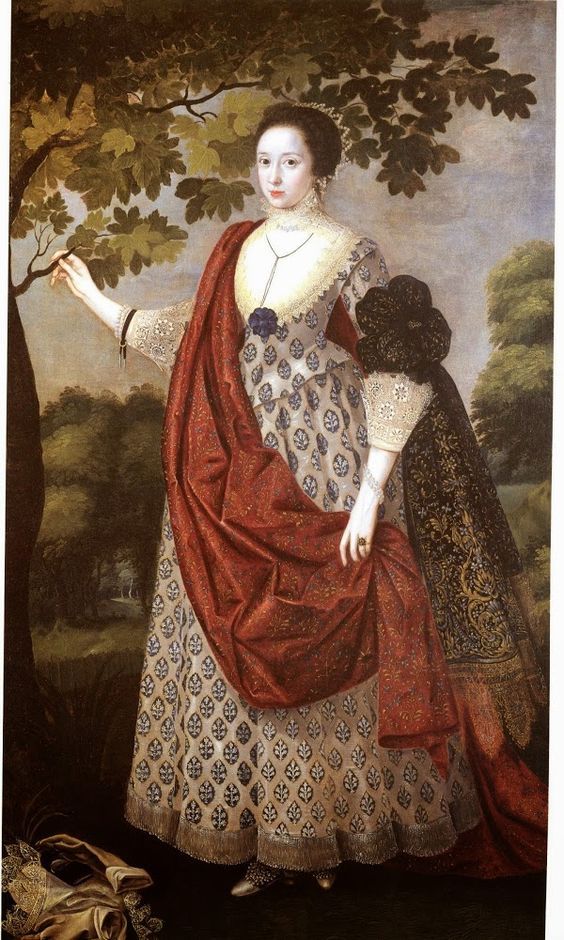

Here the first, very much showing nipples, from c. 1630. The second from 1632.
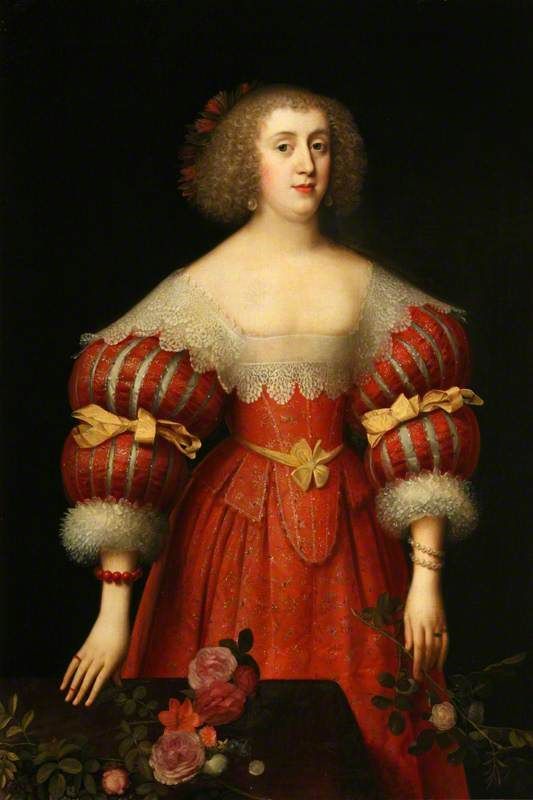
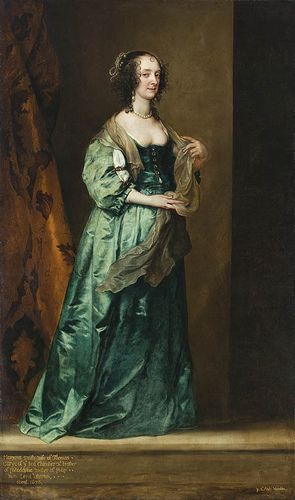
The neckline would slowly and slightly rise during the next decades, but nip slips were still expected. Here's an example from 1649 and then from 1650-55. In 1660s the neckline would get still slightly higher and by 1870s it was in a not very slippable hight. The necklines would stay low for the next century, though mostly not in boob showing territory, but we'll get there. But I will say that covering the neckline in casual context was expected. Boobs were mostly for fancy occasions. It was considered vain to show off your boobs when the occasion didn't call for it and covering up during the day was necessary for a respectable lady. You wouldn't want to have tan in your milk-white skin like a poor, and also they didn't have sun screen so burning was a reasonable concern.

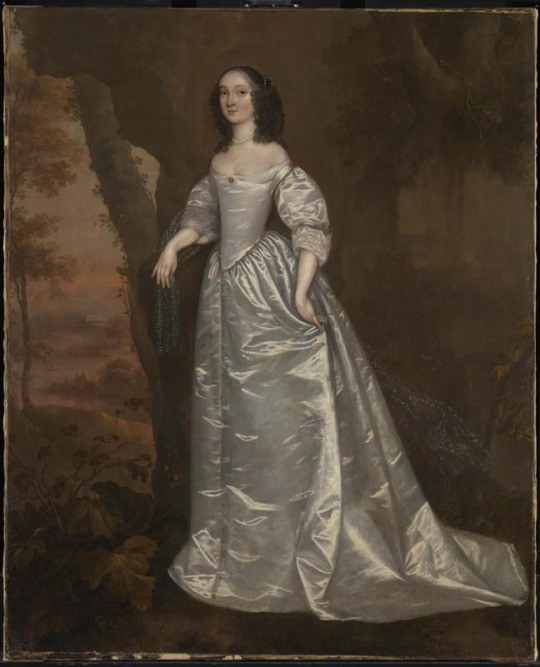
1720s to 1740s saw necklines that went to the nip slip territory, though they didn't go quite as low as 100 years earlier. The nipple was present in the French courtly fashion especially and rouging your nipples to enhance them was popular. Émilie Du Châtelet (1706-1749), who was an accomplished physicist and made contributions to Newtonian mechanics, was known in the French court to show off her boobies. An icon. Here she is in 1748. Here's another example from this era from 1728.
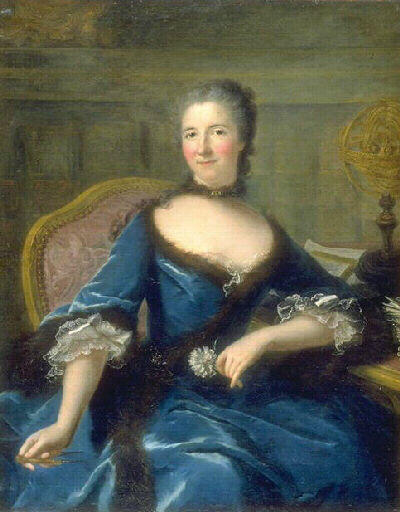
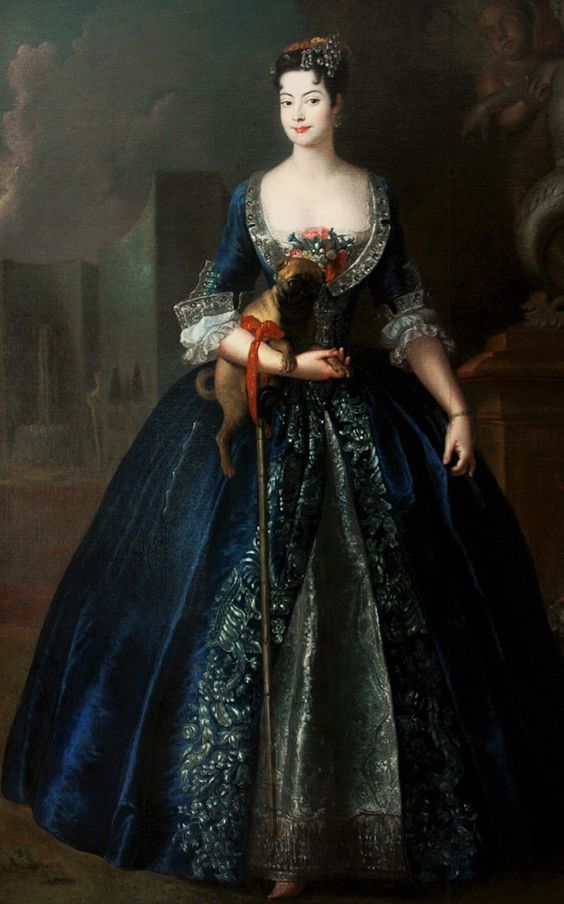
The Rococo neckline never got high, but in the middle of the century it was less low till 1770s when it plunged into new lows. In 1770s the fashion reached a saturation point, when everything was the most. This included boobs. The most boob visible. There was a change in the attitudes though. The visible boob was not a scandal, but it was risque, instead of sing of innocent and did cause offense in certain circles. I think it's because of the French revolution values gaining momentum. I talked about this in length in another post, mostly in context of masculinity, but till that point femininity and masculinity had been mostly reserved for the aristocracy. Gender performance was mostly performance of wealth. The revolutionaries constructed new masculinity and femininity, which laid the groundwork for the modern gender, in opposition to the aristocracy and their decadence. The new femininity was decent, moral and motherly, an early version of the Victorian angel of the house. The boob was present in the revolutionary imagery, but in an abstract presentation. I can't say for sure, but I think bare breasts became indecent because it was specifically fashion of the indecent French aristocracy.
Here's example somewhere from the decade and another from 1778. The neckline stayed quite low for the 1780s, but rose to cover the boobs for the 1790s.

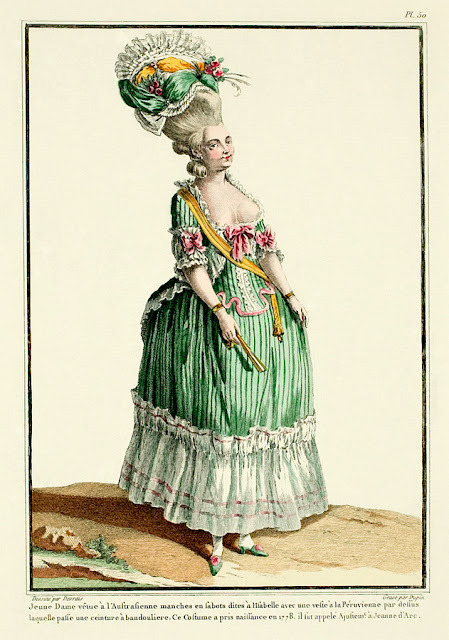
The nipple didn't stay hidden for long but made a quick comeback in the Regency evening fashion. It was somewhat scandalous by this point, and the nipple and sheer fabrics of the Regency fashion gained much scorn and satire. The styles that were in the high danger nip slip territory and those that allowed the nipple to show through fabric, were still quite popular. The sleeves had been mid length for two centuries, but in 1790s they had made a split between evening and day wear. The evening sleeves were tiny, just covering the shoulder. Showing that would have been a little too much. Like a bare boob? A risque choice but fine. A shoulder? Straight to the horny jail. (I'm joking they did have sheer sleeves and sometimes portraits with exposed shoulder.) But long sleeves became the standard part of the day wear. Getting sun was still not acceptable for the same reasonable and unreasonable reasons. Day dresses did also usually have higher necklines or were at least worn with a chemisette to cover the neckline. Fine Indian muslin was a huge trend. It was extremely sheer and used in multiple layers to build up some cover. There were claims that a gust of wind would render the ladies practically naked, though because they were wearing their underclothing including a shift, which certainly wasn't made from the very expensive muslin, I'm guessing this was an exaggeration. Especially though in the first decade, short underboob stays were fairly popular, so combined with a muslin, nipples were seen. Here's an early 1798 example of exactly that. The short stays did disappear eventually, but in 1810s the extremely small bodices did provide nip slip opportunities, as seen in this 1811 fashion plate.
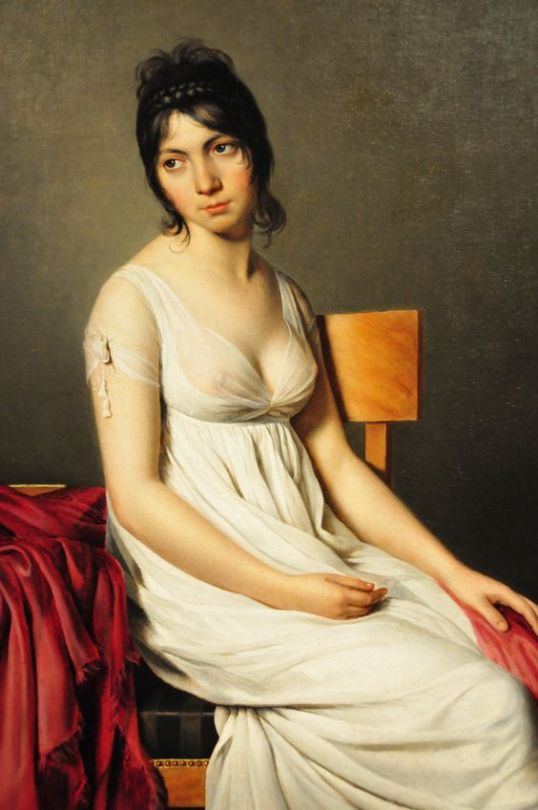
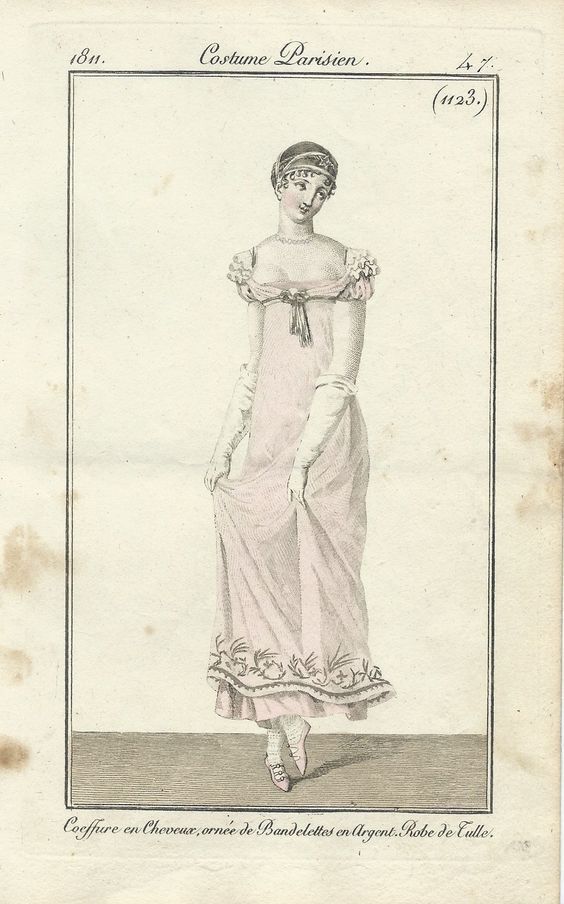
Victorian moralizing did fully kill the nip slip, though at least they were gender neutral about it. The male nipple was just as offensive to them. In 1890s, when bodybuilding became a big thing, bodybuilder men were arrested for public indecency for not wearing a shirt.
#there was also the new femininity aspect to regency nipple which had to do with breastfeeding becoming fashionable among upper class#it's about the whole motherly thing that came with the french revolution#i can't remember the book i read it from so i didn't go into it because i couldn't remember the details lol#but it did definitely have an effect to the fashion and to the perception of nipple#historical fashion#fashion history#history#dress history#fashion#answers#painting#fashion plate#renaissance fashion#elizabethan fashion#rococo fashion#baroque fashion#regency fashion#will tumblr prove itself to be again more prudish than elizabethans and label my post as mature content?#remains to be seen
504 notes
·
View notes
Text

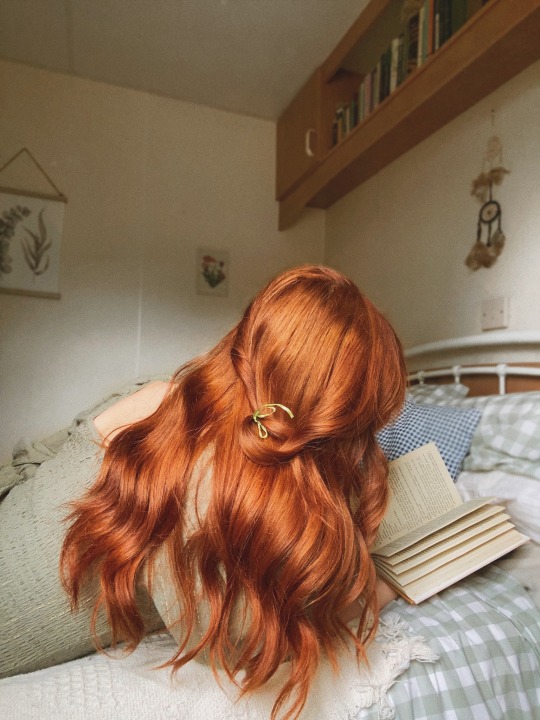
my hair is cute.
#face#mine#cottagecore#slow living#countryside living#cabincore#auburn#copper#skyrim vibes#autumn#crystals#renaissance fashion#renaissance#bookcore#bookblr#bookish#light academia#cozy academia#cozy core#hygge living#it me
506 notes
·
View notes
Photo

Crown Of Holy Roman Emperor Rudolph I, Crafted By Jan Vermeyen Of Antwerp In 1602. From The Kunsthistorisches Museum, Vienna
(source)
#crowns#holy roman empire#fashion#belgium#belgian fashion#german fashion#germany#renaissance#renaissance fashion#that is a Shape
676 notes
·
View notes
Photo
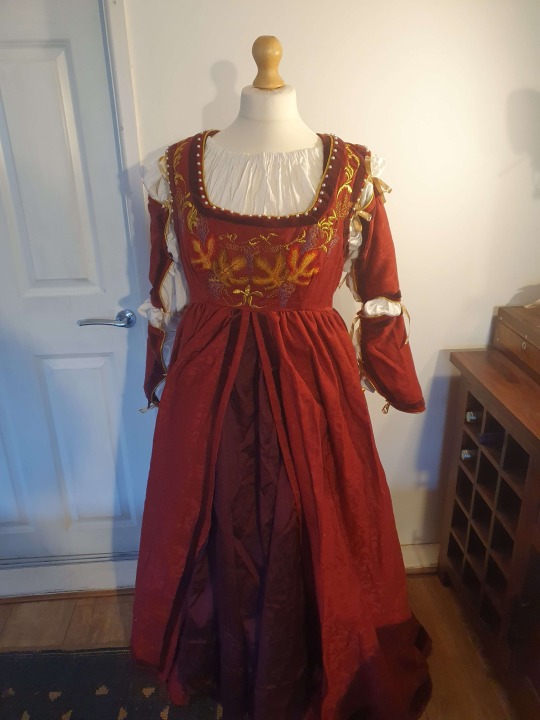
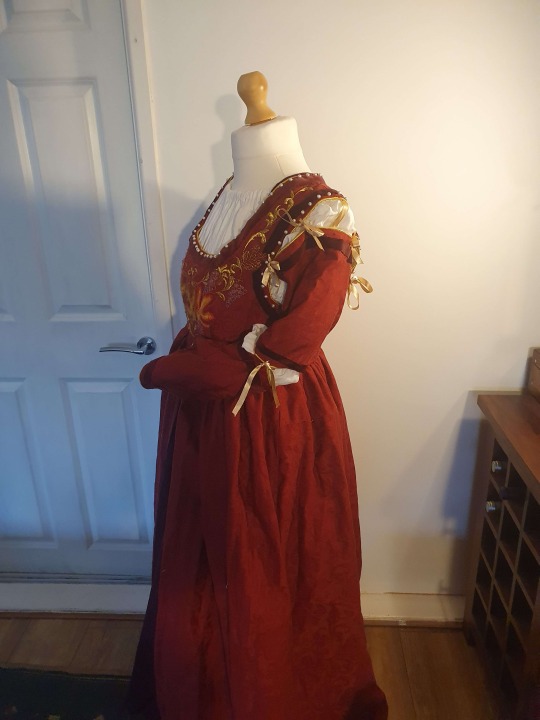


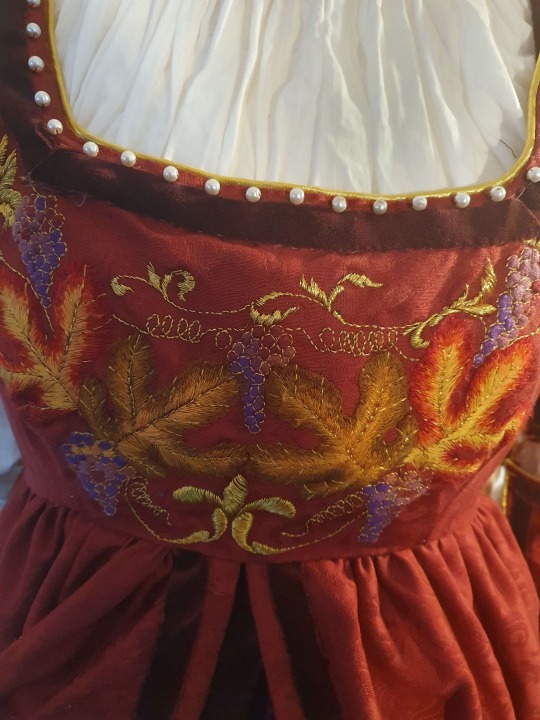
The Grapevine dress
My Etsy
#Renaissance Fashion#renaissance costume#dress#embroidery#Embroidery design#costuming#period costume#larp costume#larp kit#larp gear#medici#the borgias
106 notes
·
View notes